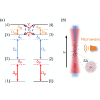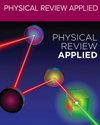Restrictions of microwave electrometry due to nonlocal interactions in Rydberg atoms
IF 4.4
2区 物理与天体物理
Q2 PHYSICS, APPLIED
引用次数: 0
Abstract
Large dipole moments between high Rydberg states have been utilized to measure microwave electric fields based on electromagnetically induced transparency, while nonlocal Rydberg interactions are not suitably addressed yet in most relevant works. Here we adopt a mean-field superatom model to investigate the main restrictions of Rydberg microwave electrometry due to nonlocal interactions in atomic samples of appropriate densities. It is found that accurate microwave measurements can be attained in the linear regime only for dilute enough atomic samples and not too strong probe fields, which jointly determine whether Rydberg excitations are insignificant. This then leads to the critical lines of atomic density and probe intensity, below which the discrepancy between measured and real values is negligible due to vanishing Rydberg interactions, for a fixed microwave or coupling field. Our findings are instructive to identify the optimal conditions for Rydberg microwave electrometry by reaching a compromise between high precisions and high accuracies, requiring, respectively, large and small numbers of Rydberg excitations, when measuring weaker microwave fields.

雷德贝格原子中的非局部相互作用对微波电学的限制
基于电磁诱导的透明度,人们利用高雷德贝格态之间的大偶极矩来测量微波电场,而大多数相关研究尚未适当解决非局部雷德贝格相互作用问题。在此,我们采用均场超原子模型来研究在适当密度的原子样品中由于非局部相互作用而导致的雷德贝格微波电学的主要限制。研究发现,只有足够稀的原子样品和不太强大的探测场,才能在线性范围内实现精确的微波测量,而这两者共同决定了里德伯激发是否不重要。这就引出了原子密度和探针强度的临界线,对于固定的微波或耦合场,在临界线以下,由于雷伯格相互作用消失,测量值和实际值之间的差异可以忽略不计。在测量较弱的微波场时,分别需要大量和少量的雷伯格激发,我们的研究结果有助于在高精度和高准确度之间达成折衷,从而确定雷伯格微波电学的最佳条件。
本文章由计算机程序翻译,如有差异,请以英文原文为准。
求助全文
约1分钟内获得全文
求助全文
来源期刊

Physical Review Applied
PHYSICS, APPLIED-
CiteScore
7.80
自引率
8.70%
发文量
760
审稿时长
2.5 months
期刊介绍:
Physical Review Applied (PRApplied) publishes high-quality papers that bridge the gap between engineering and physics, and between current and future technologies. PRApplied welcomes papers from both the engineering and physics communities, in academia and industry.
PRApplied focuses on topics including:
Biophysics, bioelectronics, and biomedical engineering,
Device physics,
Electronics,
Technology to harvest, store, and transmit energy, focusing on renewable energy technologies,
Geophysics and space science,
Industrial physics,
Magnetism and spintronics,
Metamaterials,
Microfluidics,
Nonlinear dynamics and pattern formation in natural or manufactured systems,
Nanoscience and nanotechnology,
Optics, optoelectronics, photonics, and photonic devices,
Quantum information processing, both algorithms and hardware,
Soft matter physics, including granular and complex fluids and active matter.
 求助内容:
求助内容: 应助结果提醒方式:
应助结果提醒方式:


